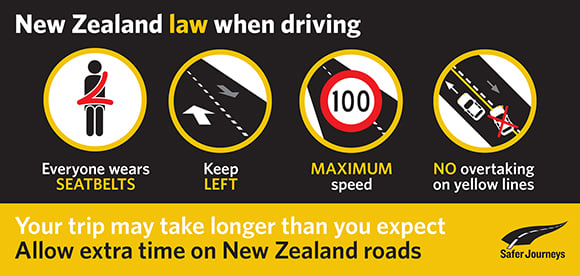NZTA and the NZ Rental Vehicle Association have begun a trial in the South Island of steering wheel tags and information cards aimed at educating overseas drivers as they get behind the wheel. A number of tourism and transport safety agencies were involved as part of the Visiting Drivers Signature Road Safety Project.
The information cards are simplistic pictorial messages outlining basic information and, mostly simply duplicate information already available in NZTA’s booklet What’s Different About Driving in New Zealand.

20,000 copies of the tags have been provided to Queenstown-based rental vehicle companies, and 20,000 cards have been supplied to tourism operators and Police to hand out to tourists. Rental vehicles also usual come with ‘keep left’ stickers on windscreens, and (when there is time) rental vehicle staff take drivers through the road rules.
While the national incidence of accidents involving drivers with a foreign licence is 4%, in Southland 25% of drivers involved in loss of control and head-on rural crashes held overseas drivers licences, and the figures are 22% in Queenstown, 15% in Central Otago and 14% in Clutha. No figures have been given, though, about whether all these are tourists or simply temporary migrant workers, or whether they were driving a rental car or their own car.
After the initiative has finished NZTA will work with Police to look at statistics for accidents and infringements to see if any difference has been made.
We have been working with rental car companies since September 2013 and launched a tourist-focussed Road Code quiz (you can try it here). With over 75,000 motorhome hires and many, many more rental vehicles hires per year, any small improvement in road rule awareness could make a large difference on our roads.
The unique problems for tourists with roads in the South Island is that they are often long and easy followed by a tricky curve that catches drivers out. They can contain uneven surfaces and gravel, plus they’re susceptible to washouts and slips. There are very few dual carriageways and motorways and therefore drivers are forced to overtake and they might not be used to that if their primary driving experience is urban driving where they live usually.
New Zealand’s scenery is particularly stunning and, if you are on a self-drive holiday, scenery is one of the main attractions.
Drivers that are not used to driving on the left can easily drift back into the right-hand lane, particularly after a one-lane bridge or a narrow single-lane road. Drivers are often driving a vehicle that is much bigger than the one they are used to, i.e. a motorhome or campervan. We also have a large amount of wandering stock in comparison to most European countries.
Our speeds are not particularly high in New Zealand, but the quality of our roads is not as good as many European roads. Add to that the lack of frequent service areas and the excruciatingly long flight required to get to New Zealand and you can see why many tourists start out their journey driving tired.
Tourists from Europe find our road signs confusing because they are completely different (other than speed limit signs). Our warning and advisory signs are yellow diamonds and have differing icons whereas they are red triangles and red circles in Europe. Our roadworks signs are different and we have a large proportion of our signs that are written English instructions, for example, keep left unless passing. Tourists that don’t speak English will have difficulties reading these signs.
We provide our Road Code quiz in English, Spanish and German as these are the predominant languages spoken in Europe, America and South America. If you are thinking of visiting New Zealand, give it a go and see how well you do.

